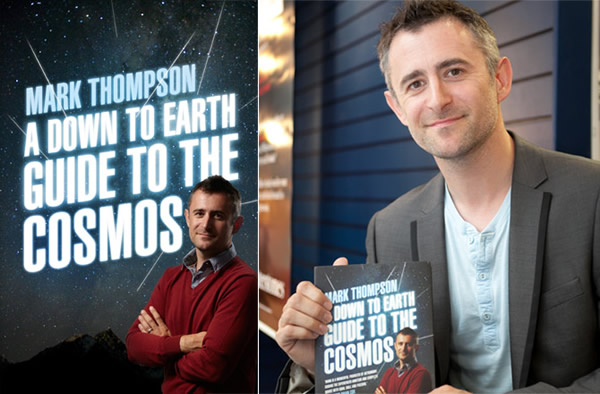A Down To Earth Guide To The Cosmos (Review)
Mark Thompson
“So what constellation is that?” she asked me as we walked along the sandy beach of my university town.
“Um. I dunno,” I replied.
Up to that point, my date was going really well. But as I saw the disappointment descend across her face, I realized that she realized I wasn’t the astronomer she thought I was.
Trying to regain some dignity, I quipped: “I’m an astrophysicist, not an astronomer. I know how stars work, not what they look like.”
The silence was deafening. The date went downhill from there.
Now, I’m not saying that to impress a lady you need to be able to navigate the night sky, but if I’d only bothered to remember a few constellations from my practical astronomy lectures, this particular night of my undergraduate days could have turned out a whole lot different. Lesson learned: Having knowledge of astronomy can complement a romantic night, but saying you spend most of your waking hours running magnetohydrodynamic code on a computer, not so much.
And so, from this logic, I wholeheartedly believe that Discovery News writer and BBC astronomy presenter Mark Thompson doesn’t only know his way around the celestial sphere, his romantic walks were a lot more exciting than mine.
This theory was confirmed when I read Mark’s brand new book “A Down To Earth Guide To The Cosmos” (Bantam Press, ISBN 978-0-593-07036-9) — I was captivated by the tour of astronomy he gave.
A Down To Earth Guide is a thoroughly good read that not only explores the stars and constellations, it also delves into some of the more complex astrophysical mysteries in our Universe. With his trademark wit, Mark is able to easily link these mysteries with their historical significance. Then, with no effort at all, he whisks the reader off onto a journey into deep space, guiding us from one star, planet, nebula or cluster to the next, helping us understand not only where to point our telescopes, but also the drama and romance of being an astronomer.
Naturally, Mark also packs his book with hints and tips on what equipment you need — perhaps surprisingly, much astronomy can be done by simply looking up, without the aid of an expensive telescope.
But the real strength of the book is its great structure and ease of reading. He communicates what the Cosmos means to him and by doing so imparts a little of his infectious enthusiasm to the reader. By the end, you’ll want to go outside on a clear night to follow Mark’s sky guides and learn a little about each celestial object you see. He has excellent month-by-month guides (for Northern and Southern Hemisphere skies) that are separated by chapters about dark matter, the life cycles of stars, meteors, meteorites and asteroids. He also delves into the big question: How will our world really end? He also voyages from our tiny solar system, expanding the horizons to the epic spaces between the galaxies.
In the center of the book, Mark showcases some stunning astronomical photography, taken not by the Hubble Space Telescope, but by amateur astronomers, schools, colleges and himself. This underlines who Mark is — not an unreachable, unfathomable academic, but an approachable, down-to-Earth guy who wants to share his passion. He is the “People’s Astronomer” — as underlined by his Twitter handle “@PeoplesAstro” and his awesome presenting work in the UK for the BBC.
If you are familiar with Mark’s Discovery News articles, you know what to expect. His boyish enthusiasm mixed with decades of astronomical experience gives Mark’s book a depth that you rarely find in other astronomy “guides.” I wholeheartedly recommend A Down To Earth Guide as an entertaining, exciting read, but also as solid reference material for any amateur astronomer.
Still need convincing? Take a look at Mark in action: “It’s behind you, Mark!”
You can buy A Down To Earth Guide To The Cosmos via Amazon.com and find out more information about Mark and his adventures on his website.(May 31, 2013 01:49 PM ET // by Ian O'Neill)












